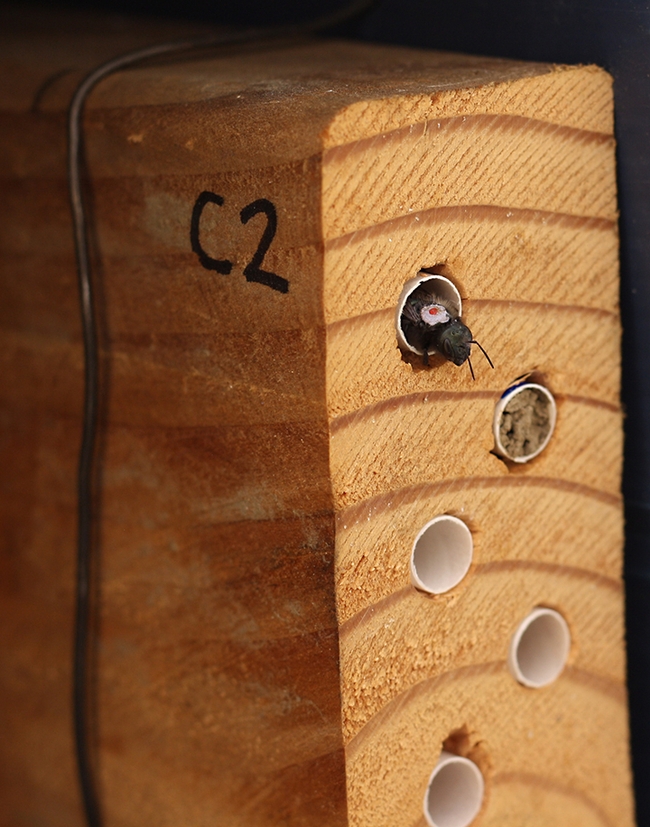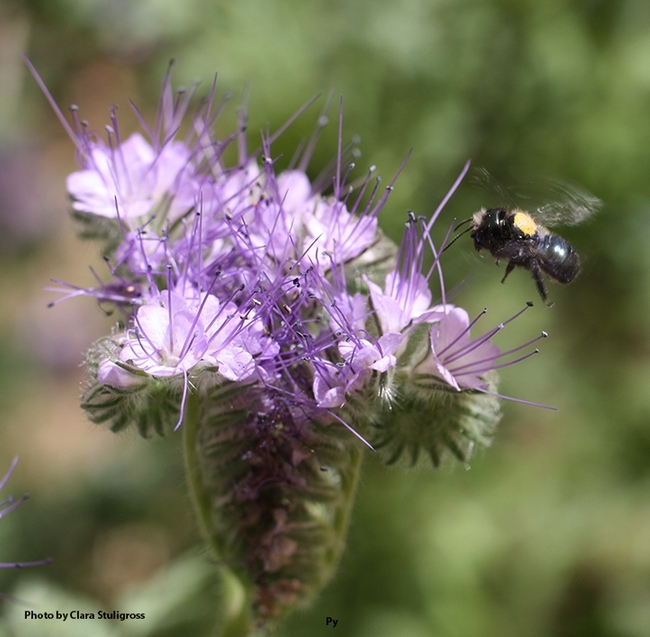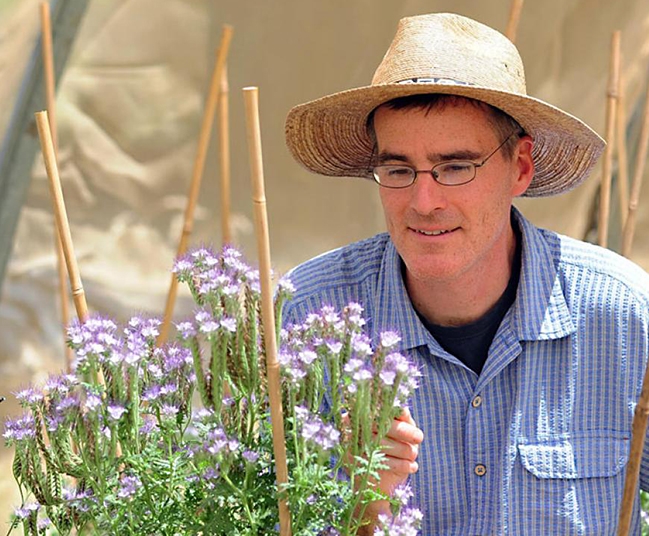
"Imidacloprid disrupts the nerve's ability to send a normal signal, and the nervous system stops working the way it should," says the National Pesticide Information Center (NPIC).
Used in products sold in the United States since 1994, "Imidacloprid is much more toxic to insects and other invertebrates than it is to mammals and birds because it binds better to the receptors of insect nerve cells," according the NPIC's Fact Sheet.
Now a newly published, two-year UC Davis study reveals that normal exposure to imidacloprid generates a multi-generational effect on the blue orchard bee, Osmia lignaria, reducing both reproduction and population growth.
The research, "Past Insecticide Exposure Reduces Bee Reproduction and Population Growth," by doctoral ecology candidate Clara Stuligross and her co-author, major professor Neal Williams of the UC Davis Department of Entomology and Nematology, is published in the current edition of the Proceedings of the National Academy of Sciences.
The blue orchard bee, sometimes nicknamed BOB, is a native bee active in the early spring. Metallic blue in color and smaller than a honey bee, it is a solitary mason bee often managed commercially to pollinate almond orchards. The bees are also considered excellent pollinators of apple, pear and cherry trees and efficient pollinators of blueberries.
“We reveal that pesticide exposure, both directly to foraging bees and via carryover effects from past exposure, dramatically reduced bee reproduction, which reduced population growth,” they wrote. “Carryover effects reduced bee reproduction by 20% beyond current impacts on foraging bees, exacerbating the negative impact on population growth rates. This indicates that bees may require multiple generations to recover from a single pesticide exposure; thus, carryover effects must be considered in risk assessment and conservation management.”

The scientists investigated the effects of current exposure and the carryover effects of past insecticide exposure on the individual vital rates and population growth of the bee. “Bees in flight cages freely foraged on wildflowers, some treated with the common insecticide, imidacloprid, in a fully crossed design over two years, with insecticide exposure or no exposure in each year,” they wrote.
They found that “insecticide exposure directly to foraging adults and via carryover effects from past exposure reduced reproduction. Repeated exposure across two years additively impaired individual performance, leading to a nearly fourfold reduction in bee population growth.”
“Exposure to even a single insecticide application can have persistent effects on vital rates and can reduce population growth for multiple generations,” they wrote. “Carryover effects had profound implications for population persistence and must be considered in risk assessment, conservation, and management decisions for pollinators to mitigate the effects of insecticide exposure.
The 2018-2019 study took place on the grounds of the Harry H. Laidlaw Jr. Honey Bee Research Facility, located west of the central UC Davis campus.
The researchers tested only imidacloprid, a commonly used pesticide related to nicotine, and in exposures that bees would normally encounter in an agricultural field or orchard. The bees visited three species of wildflowers: lacy phacelia (Phacelia tanacetifolia), great valley phacelia (Phacelia ciliata), and purple Chinese houses (Collinsia heterophylla).
Any other adverse effects of the pesticide exposure? “We also saw effects of current pesticide exposure on offspring sex ratio, probability of nest initiation, and nest construction rate,” Stuligross said.
Financial Support. The study drew financial support from Stuligross' National Science Foundation Graduate Research Fellowship; her UC Davis Henry A. Jastro Graduate Research Award, and her UC Davis Ecology Graduate Research Fellowship, as well as from the UC Davis Department of Entomology and Nematology through the Harry H. Laidlaw Jr. Bee Research Facility and the Laidlaw Endowment.
The next step? “We are interested in studying how this type of pesticide exposure affects bees in a full field setting, where bees are exposed to multiple stressors simultaneously," she said.
Unlike honey bees, the reproductive rate of the blue orchard bee is low. A queen honey bee can lay about 2000 eggs a day in peak season, while the female blue orchard bee lays about 15 eggs a year.
Stuligross, who began her doctoral studies at UC Davis in 2016, holds a bachelor's degree in environmental studies (2014) from Earlham College, Richmond, Ind. “I am broadly interested in bee biology, population ecology, and understanding how bees interact with their environments in natural and managed ecosystems,” she says. “I use a combination of landscape, field cage, and lab experiments to study these interactions at different scales.”
Stuligross previously worked as a science educator at Carnegie Museum of Natural History, a research technician with Rufus Isaacs at Michigan State University studying bee communities in blueberry fields. I was also an undergraduate researcher with T'ai Roulston, Rosemary Malfi, and Wendy Tori studying bumble bee foraging, parasitism, and ecological niche modeling.
Stuligross and Williams assisted with the production of the KQED Deep Look video, "Watch This Bee Build her Bee-Jeweled Nest," posted Aug. 7, 2018. The video notes that most of the 4000 bees in North America are solitary. Mason bees, or "builder bees," build their nests with mud, and provision their nests with nectar and pollen for their offspring.
In nature, the blue orchard bees use hollow tubes, such as reeds. The UC Davis lab uses wood blocks or "bee condos" drilled with specially sized holes, each filled with a removable six-inch-long paper straw. Almond growers who manage blue orchard bees provide drilled wood blocks in their orchards. The bee condos are also popular among backyard gardeners.
More Information:
- Pesticides Can Affect Multiple Generations of Bees (UC Davis story by Amy Quinton)
- The Blue Orchard Mason Bee (U.S. Forest Service website, article by Beatriz Moisset and Vicki Wojcik, Pollinator Partnership)
- Imidacloprid Fact Sheet, National Pesticide Information Center
- Imidacloprid, Wikipedia
Attached Images:

